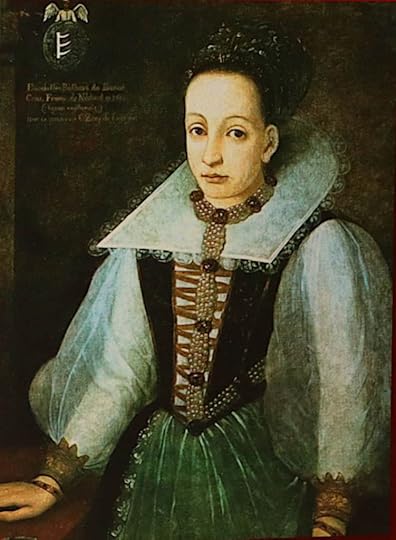Ripley Entertainment Inc.'s Blog, page 46
January 12, 2023
Elizabeth Báthory Would Bathe In Blood?
Featured in Ripley's Believe It or Not!

Throughout history, humanity has been plagued by cruel, terrible and vicious serial killers. The specter of Jack the Ripper, for instance, looms large over London’s history today, just as the killer themselves did over the smoky streets of the city’s Whitechapel region.
Who was Jack? Why did they kill? We will probably never have any sure answers to these questions, though many have been suggested. The only thing that can be said for sure is that the notoriety of this 19th century villain is eternal. So is that of Countess Elizabeth Báthory, a killer of perhaps equal infamy. According to the gory story, she bathed in the blood of her unfortunate victims!
Who Was The Infamous Blood Countess?Who, then, was this dreaded blood-bather? Elizabeth Báthory, or Báthory Erzsébet in her native Hungarian, was born in Nyírbátor on August 7, 1560. The Blood Countess, as she would be known in the centuries to come, was born into a prominent family who held power over an ironic region: Transylvania, which was then part of Hungary.
Transylvania is also infamous for the reputation of one Vlad the Impaler, but the well-known story is actually far from the truth. Professor Florin Curta of the University of Florida stated to Live Science, “Dracula is linked to Transylvania, but the real, historic Dracula — Vlad III — never owned anything in Transylvania.”
Báthory also has bloodthirsty ties to Transylvania, and has gained a terrible reputation as one of the worst female serial killers in history. In fact, she actually holds a Guinness World Record for the most prolific female murderer ever, with a claimed 600 victims!

Elizabeth Báthory. Via Wikimedia Commons.
Her alleged crimes are the stuff of morbid legend, but, again, the fact must be separated from the fiction in this extraordinary case, and that’s proven surprisingly difficult. Let’s take a closer look at the awful things she was accused of.
As the Countess grew up, it seems that she received a lot of distinctly dark instruction and influences from her family. An uncle supposedly introduced her to Satanism. It was when she married Count Naday that some of these influences and the Countess’ own inherent cruelty and dark interests began to truly emerge. When the Countess moved into her lavish new home of Csejthe Castle with her husband, she was only fifteen years old. Even at that tender age, it seems that it was clear she had some very macabre and evil appetites: she reportedly asked Count Naday to build a grim torture chamber in the castle, and he did just that.
Naturally, the sort of person who requests a ghastly torture chamber in their home won’t tend to want it just for decorative purposes. Over the years, according to reports, Báthory utilized her grisly repertoire in the most horrific ways.
Catching The CountessIn 1609/10, the tales of Báthory’s alleged vicious deeds had reached fever pitch. She would be a formidable opponent for law enforcement, being of such high standing and as well-connected as she was, and ‘justice’ has long favored such people. Nonetheless, some crimes (or the stories regarding them) are so heinous that nobody is above reproach.
In the end, Csejthe was investigated by officers dispatched by the Hungarian King himself, Mathias II. These officers, according to Valentine Penrose’s Las Comtesse Sanglante (“The Bloody Countess”), managed to sneak into the Countess’s illustrious home, hoping to find (or perhaps hoping not to find) evidence to support the horrifying stories told by the local people: of disappearing women and girls, of the foulest of foul play, of blood-curdling screams emanating from Csejthe Castle. This, and more, they certainly uncovered, and it makes for grim reading indeed.
All the time, it seems, they were fearful of the Countess’s wrath, believing (as did many) that she was a formidable practitioner of Dark Magic.
The men snuck into the castle, not wanting to alert the Countess to the fact that she was suspected of various horrors. On making their way in, they soon found that something of the stories was true.
According to the account from the book, the Countess had not troubled to bar access to her imposing home, and a door was left open. The men simply entered, and after being startled by a reported total of six cats (which were said to be another connection to Bathory’s witchcraft), they found a human victim. They appeared to have been drained of their blood, as though by a particularly persistent vampire. The young girl was dead, and she lay next to another, who barely stirred, her body cruelly pierced multiple times and, likewise, her blood appearing to have been extracted.

Csejthe Castle. Credit: LMih Via Wikimedia Commons (CC BY-SA 3.0)
The dungeons of Csejthe Castle held several more girls and women, the story goes on, and those whose legs could still carry them escaped at the hands of the bold visitors. The awful question remained: Why had the vicious Countess seemingly wanted these unfortunate peoples’ blood?
It has been claimed that Báthory had a particularly grotesque motivation: she would bathe in the blood of the unfortunate victims. By so doing, she reportedly believed, she would be able to maintain her youth. One account adds an intriguing element to this aspect of the awful story: Báthory was, it seems, epileptic, and during her childhood servants’ blood would be applied to her lips as a supposed ‘cure.’ Had this happened to her from an early age, it would be easy to draw a connection to the woman she became: cruel and with a fixation on drawing (and intimately applying) blood.
Were The Allegations True?In December of 1609, according to one account, Báthory was arrested by the Palatine of Hungary: György Thurzó. This, author Ann Foster states, was not an act of righteous justice. Thurzó, after the death of Báthory’s husband, seemed to see her and her great wealth and influence as vulnerable. In what may well have been his zeal to become even more powerful himself, he moved against her. Per this account, brutal treatment and killing of servants was not, itself, an arrestable offense, as it was largely standard behaviour among a ruling class vengeful and afraid of another revolt. ‘Notable’ females supposedly become victims too, as they visited the cultured and connected Countess to further their educations. If girls and women of standing had been harmed by these horrors, it seems, the matter became one of importance.
The investigation, which questioned many who lived near the castle, reportedly concluded that the Countess had an incredible number of victims: around 600, as Guinness World Records claims, had been murdered or tortured by her. However, these claims were never proven. It could well have been a nefarious plot to discredit the Countess and so take control of all that one of the most powerful women of her time possessed.

Portrait of Elizabeth Báthory (1560-1614). Via Wikimedia Commons.
Three members of Báthory’s staff, who were accused of aiding her in her alleged evil deeds, were executed after their trial two years later. She herself, as influential as she was, did not face trial, and there’s the rub: her opponents and accusers wielded considerable power themselves (among them was the Hungarian king himself, Matthias, whose great debt to Báthory was cancelled by her family in exchange for her ultimately lenient ‘sentence’), and her serving staff had little chance of faring well in the trial or challenging its conclusions. The Countess’s true guilt, or otherwise, is now all but impossible to prove.
Ultimately, she was confined to her castle until her death in August 1614. Whether she was a blood-bathing serial killer on an enormous scale remains unconfirmed, though one thing is absolutely certain: Some very important people of her time stood to gain an awful lot by painting her as such.
By Chris Littlechild, contributor for Ripleys.com
EXPLORE THE ODD IN PERSON! Discover hundreds of strange and unusual artifacts and get hands-on with unbelievable interactives when you visit a Ripley’s Odditorium!Inflation You’ll Like: Massive Balloon Creations by Mike Verge
Featured in Ripley's Believe It or Not!

Mark Verge of Oshawa, Ontario, specializes in larger-than-life balloon sculptures that require thousands of inflatables to assemble!
Behind the BalloonsMark began twisting balloons about 30 years ago and has placed first in a dozen global competitions and is an eight-time, world champion balloon artist! Today, he offers his unique set of skills through his appropriately named business, Xtreme Balloons.
Some of his incredible creations include a life-size car from The Flintstones (complete with Fred and Dino), Bumblebee from Transformers, Baymax of Big Hero 6, the titular characters from Alien vs. Predator, and so many more.

However, Mark’s most popular designs are his life-size dinosaur creations! His first prehistoric beast was a T. rex skeleton made of more than 1,400 balloons. Believe It or Not!, the dino measured 39 feet long and took 55 hours to create! Some of Mark’s other balloon dinos include Stegosaurus, Utahraptor, Allosaurus, and Spinosaurus.
Dino-Mite CreationsMark’s balloons have popped up all over the place. The Royal Ontario Museum in Canada has commissioned dinosaur skeletons from Mark twice: a 39-foot long T. rex in 2008 and a 20-foot long Triceratops in 2015.
South of the border in the U.S., Mark created a T. rex for Field Station: Dinosaurs, and on the other side of the world he made a T. rex balloon costume in Shanghai.


Mark has made a variety of costumes, life-size dinosaurs, and even interactive creations but has said that his favorite sculpture to make was a 10-foot-tall Bumblebee, from the Transformers movie.

Check out Mark’s Instagram to see more of his incredible work from throughout the years. We, here at Ripley’s, think you’ll find it poppin’!
Escape the Ordinary With Ripley’s Latest Book!Find this story and more inside Ripley’s all-new book! Escape the Ordinary‘s 256 pages spark curiosity, challenge perception, celebrate differences, and curate a sense of wonder for the weird world around us! Available now on Amazon and at most major retailers.
SAY “NO” TO NORMAL Ripley’s Believe It or Not! Escape the Ordinary transports readers of all ages to a world beyond imagination — where truth is always stranger than fiction! Every turn of the page reveals all-new and all-true stories from around the globe. Filled with stunning photography and engaging content, this book is every curious reader’s ticket to Escape the Ordinary.Source: Inflation You’ll Like: Massive Balloon Creations by Mike Verge
CARTOON 01-12-2023
January 11, 2023
Trees are Migrating West, and Scientists Aren’t Exactly Sure Why
Featured in Ripley's Believe It or Not!

Research shows that for the past 30 years trees from the eastern United States have been shifting westward at a whopping 9.5 miles per decade. This is perplexing to scientists, who believed that climate change would force species to seek familiar climates at the earth’s poles. But instead of moving north, they’re moving west, reports Science Alert.
Even more odd is that changes in rainfall and precipitation only account for a tiny part of the migration, suggesting that there’s more going on than the scientists know about.
Moving at a Tree-mendous PaceResearch about the phenomena was published in Science Advances, and the results were “a huge surprise,” according to Purdue University ecologist and lead researcher Songlin Fei. The research team examined U.S. Forest Service data from 1980 to 2015. The 86 species of trees analyzed were located between Maine and Minnesota and southern states such as Florida.
The trees were more likely to shift west (73 percent) than north (62 percent), and younger specimens followed this trajectory more so than older ones. Some trees moved northwest.
Trees are migrating west to escape climate change https://t.co/jwgbuQiu77 pic.twitter.com/RCArKpWKG2
— Popular Science (@PopSci) October 17, 2018
No, these trees aren’t physically uprooting themselves and relocating; they are shifting the centers of their populations over time to areas that provide more conducive living conditions. Saplings are drawn to more friendly habitats, and once the older trees die, the younger ones have taken up residence in new places. Northward moving trees have been traveling about 6.8 miles per decade compared to westward-moving species at 9.5 miles per decade. Very few trees have migrated south or east, according to the data.
A Changing ClimateGlobal warming may have something to do with the westward movement, according to the report. The temperature in the United States increased 0.29-degrees Fahrenheit between 1980 and 2015, and elevated temperatures in the eastern part of the country have affected rainfall totals. Areas like the southeast have experienced lower rainfall levels. Broad-leaf species such as deciduous trees are shifting towards areas with more rain, while evergreen trees have been moving north.

Changes in temperature and precipitation between the recent past (1951–1980) and the study period (1981–2014) across the eastern United States. Via Science Advances.
However, only 20 percent of the trees’ shift in movement may be caused by adjustments in precipitation, according to the researchers. Even though it’s wetter in the west these days, it’s not wetter than the areas in which the trees originated in the east. Plus, every species reacts differently to climate change and human activity. As a result, the reason for the trees’ movement is more than just increasing temperatures and climate change. Other causes may include the implementation of conservation and planting projects, different ways humans are using the land, and pest infestations. These factors need to be examined to determine a more concrete reason for the phenomena.
According to the report, “The resultant divergent spatial shifts among various groups can have significant ecological consequences and possible extinction of certain evolutionary lineages in some forest communities.”
By Noelle Talmon, contributor for Ripleys.com
EXPLORE THE ODD IN PERSON! Discover hundreds of strange and unusual artifacts and get hands-on with unbelievable interactives when you visit a Ripley’s Odditorium!Source: Trees are Migrating West, and Scientists Aren’t Exactly Sure Why
CARTOON 01-11-2023
January 10, 2023
Rare Whale Birth Witnessed by California Coast Tourists
Featured in Ripley's Believe It or Not!

The last few years have seen fascinating interactions between whales and humans. For anyone who needs a refresher, consider these top news stories. In November 2020, a surfacing humpback whale shot two California kayakers into the air. Then, in June 2021, a Massachusetts man diving for lobsters got briefly swallowed by a humpback whale. In July 2021, whale watchers off the coast of Japan spotted an incredibly rare white orca, and whale watchers on the South African Coast got an eyeful of shark-liver-eating serial killer whales.
Now, tourists on a boat off the coast of Dana Point, California, can add another exhilarating whale experience to the list: a live birth. Here’s everything you need to know about the gray whale who brought new life into the world in front of a live audience.
Mistaken for a Whale in DistressHuman beings are known for giving birth in unusual places, from Six Flags to Walmart and even the Red Sea. Of course, whales don’t have as much choice regarding where or how they birth babies. After all, being water-bound puts a major damper on terrestrial activities. But that didn’t stop one gray whale mom from making a big splash with the birth of her calf.
Sure, she couldn’t pick a supermarket or theme park for the momentous occasion, but she still shocked passersby. More specifically, she grabbed the attention of passengers aboard Captain Dave’s Dolphin and Whale Watching Safari. As the boat approached the gray whale, they thought she might be distressed.
According to the captions of the video below, “For a minute, many of us thought it may be a shark or predatory event. But no, instead of the end of life, it was the beginning of a new one.”
A Once-in-a-Lifetime SightAlthough catching a live whale birth on the water is remarkable enough, it proves especially rare for gray whales. They usually give birth and start nursing their calves in lagoon waters off Mexico’s Baja Coast. These lagoons — Magdalena Bay, San Ignacio Lagoon, and Laguna Ojo de Liebre — provide the ideal location for whales to start raising their calves without concerns about predators.
Gray whales typically stay in Baja through mid-February to mid-March, where they enjoy socializing and hanging out in the calving lagoons. Sometimes new mothers and their babies remain in Baja until mid-May. These examples of typical whale behavior make what California whale watchers witnessed in early January genuinely one-of-a-kind.
But the most amazing thing remains the incredible transformation this adorable little gray whale calf will undergo during the next year. “Gray whale calves are about 15 feet long when they’re born and will gain over 50 pounds a day feeding on their mother’s milk.” What’s more, the little guy will participate in one of the greatest mammal migrations in the world, traveling between 10,000 and 14,000 miles between Mexico’s welcoming lagoons and the frigid waters of the Arctic.
By Engrid Barnett, contributor for Ripleys.com
EXPLORE THE ODD IN PERSON! Discover hundreds of strange and unusual artifacts and get hands-on with unbelievable interactives when you visit a Ripley’s Odditorium!Source: Rare Whale Birth Witnessed by California Coast Tourists
CARTOON 01-10-2023
January 9, 2023
CARTOON 01-09-2023
January 8, 2023
CARTOON 01-08-2023
January 7, 2023
CARTOON 01-07-2023
Ripley Entertainment Inc.'s Blog
- Ripley Entertainment Inc.'s profile
- 52 followers










